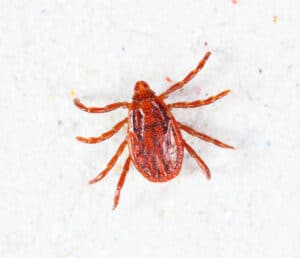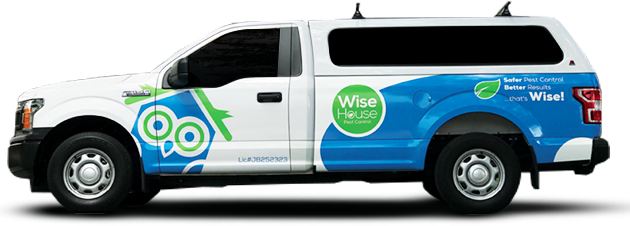As you enjoy a leisurely walk with your dog, it’s important to be vigilant for ticks, particularly brown dog ticks. These parasites can be a significant health risk for your pet and may even move into your home. After a tick has fed, it becomes noticeable and feels like a small bump on your dog’s skin. To ensure your pet’s well-being, it’s important to regularly check for ticks, especially in areas around the head, neck, ears, and feet.
Understanding how to identify and address tick infestations is important for protecting your pet from potential health issues. In this post, we provide you with detailed information on how to effectively manage and prevent brown dog tick infestations in your South Florida home.

The brown dog tick (Rhipicephalus sanguineus), also known as the kennel tick, is a common parasitic tick that primarily infests dogs but can also bite humans. These ticks are known for their ability to thrive in indoor environments and their role in transmitting diseases.
The brown dog tick is adapted to a unique lifestyle, with a life cycle and behaviors that facilitate its survival in both indoor and outdoor environments.
Life Cycle
Behavior
Feeding Habits— Brown dog ticks feed by attaching to a host and consuming blood. The feeding process can last from several hours to a couple of days. They inject saliva containing anticoagulants to facilitate feeding, which can also transmit pathogens.
Infestation Patterns— Unlike many other ticks, brown dog ticks are well-adapted to indoor environments. They can infest dog beds, carpets, and other indoor areas where they can find hosts. They are less likely to be found on outdoor vegetation compared to other tick species.
Disease Transmission— Brown dog ticks are known vectors for several diseases, including Ehrlichiosis, Babesiosis, and Anaplasmosis. They can also transmit pathogens to humans, although this is less common. The risk of disease transmission is higher in areas with dense tick infestations.
Habitat
Brown dog ticks prefer indoor environments where they can find consistent hosts. They thrive in homes, kennels, and veterinary clinics, especially in areas where dogs spend a lot of time. Outdoors, they are found in areas frequented by dogs, such as yards and parks. By recognizing their unique adaptation to indoor environments and their ability to infest homes, you can take steps to protect your pets and living spaces from these persistent parasites.
Use Effective Tick Preventatives
Regular Grooming and Check-Ups
Home And Yard Maintenance
Outdoor Precautions
Professional Pest Control
If you’re dealing with a significant tick problem, consider hiring a professional pest control service that can treat your home and yard for ticks. They can provide targeted treatments to help eliminate ticks and prevent future infestations.
Tick Removal
Use Tweezers— If you find a tick on your pet, use fine-tipped tweezers to remove it. Grasp the tick as close to the skin as possible and pull it out steadily without twisting.
Clean the Area— After removal, clean the bite area with soap and water or an antiseptic.
Monitor Your Pet’s Health
Keep an eye on your pet for any signs of illness, such as fever, lethargy, or loss of appetite. If any symptoms develop, consult your veterinarian.
Protecting your pets from brown dog ticks in South Florida requires a combination of effective treatments, regular grooming, and diligent home and yard maintenance. By staying proactive and following these tips, you can minimize the risk of tick infestations and ensure your pets remain healthy and happy. Regular vigilance and preventive measures are key to keeping these pests at bay and maintaining a tick-free environment for your pets.
Brown dog ticks are reddish-brown, flat, and about the size of a sesame seed. You can often find them on your pet’s ears, neck, between toes, or under their tail. If your pet is scratching excessively or you notice small red bite marks, it’s time to check for ticks.
Brown dog ticks can transmit diseases like ehrlichiosis and babesiosis, which can cause symptoms like fever, lethargy, weight loss, and anaemia in pets. If you suspect your pet has been bitten, contact a vet immediately.
Use vet-approved tick prevention products such as collars, topical treatments, or oral medications. Regularly check your pets for ticks, especially after spending time outdoors, and keep your home and yard clean by trimming grass and controlling tick habitats.
Carefully remove the tick with fine-tipped tweezers, grasping it as close to the skin as possible. Pull upward steadily to avoid leaving any parts behind. Clean the bite area with antiseptic and monitor your pet for any signs of illness.

Ready to send away pests without harming your pets? Getting started with Wise House Environmental Services is as easy as 1-2-3:
With Wise House Environmental Services, you get more than just effective pest control; you get peace of mind, knowing that your home is without pests and safer for your pets.
Our approach to pest control combines science with safety, offering you the kind of targeted, effective solutions that you won’t find with just any other pest control service. Our services have made a world of difference for homeowners, and we can do the same for you. Your pets will thank you for it!
We serve Port St. Lucie,Lake Worth, Boyton Beach, Palm Beachand the Treasure Coast.


© 2023 All Rights Reserved. | Sitemap